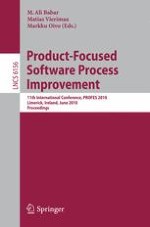On behalf of the PROFES Organizing Committee we are proud to present the proce- th ings of the 11 International Conference on Product-Focused Software Process Improvement (PROFES 2010), held in Limerick, Ireland. Since the first conference in 1999 the conference has established its place in the software engineering community as a respected conference that brings together participants from academia and industry. The roots of PROFES are in professional software process improvement motivated by product and service quality needs. The conference addresses both the solutions found in practice as well as relevant research results from academia. To ensure that PROFES retains its high quality and focus on the most relevant research issues, the conference has actively maintained close collaboration with industry and subsequently widened its scope to the research areas of collaborative and agile software devel- ment. The main themes of this year’s conference were “Agile and Lean Processes” and “Engineering Service-Oriented Systems. ” These two main themes enabled us to cover the contemporary software devel- ment demands and trends in a comprehensive manner and to tackle the most important current challenges identified by the software industry and software research com- nity––namely, the shift of focus from "products" to "services. ” The technical program featured invited talks, research papers, and experience reports on the most relevant topics related to processes for developing software-intensive services and products. In addition, a number of workshops and tutorials were hosted.
